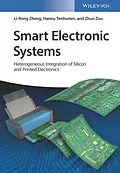Unique in focusing on both organic and inorganic materials from a system point of view, this text offers a complete overview of printed electronics integrated with classical silicon electronics.
Following an introduction to the topic, the book discusses the materials and processes required for printed electronics, covering conducting, semiconducting and insulating materials, as well as various substrates, such as paper and plastics. Subsequent chapters describe the various building blocks for printed electronics, while the final part describes the resulting novel applications and technologies, including wearable electronics, RFID tags and flexible circuit boards.
Suitable for a broad target group, both industrial and academic, ranging from mechanical engineers to ink developers, and from chemists to engineers.
Autorentext
Li-Rong Zheng is professor in Media Electronics at the Swedish Royal Institute of Technology (KTH) in Stockholm, Sweden, as well as founder and director of iPack VINN Excellence Center. Since 2010, he holds the position as a distinguished professor and director of ICT School at the Fudan University in Shanghai, China. His research interests include electronic circuits, wireless sensors, systems for ambient intelligence and the internet-of-things.
In 2001, he received his Ph.D. degree in electronic system design from the Swedish Royal Institute of Technology (KTH) in Stockholm, Sweden.
He has authored more than 400 scientific publications. He is member of the steering board of the International Conference on Internet-of-Things.
Hannu Tenhunen is professor at the Swedish Royal Institute of Technology (KTH) in Stockholm, Sweden, and holds invited and honorary professorships in Finland, USA, France, China and Hong Kong. During the last 20 years he has been actively involved in high technology policies, technology impact studies, innovations and changing the educational system. For instance, he was director of various European graduate schools and he was Education Director of the new European flagship initiative European Institute of Technology and Innovations (EIT) and the Knowledge and Innovation Community: EIT ICT Labs.
He has authored more than 700 scientific publications and holds 9 patents. Furthermore, he was one of the originators of the interconnect-centric design, globally asynchronous/locally synchronous concept and network-on-chip (NoC) paradigms.
Inhalt
Preface xi
Acknowledgment xiii
Part I Materials and Processes for Printed Electronics 1
1 Introduction 3
1.1 Connected SmartWorld 3
1.2 Smart Electronic Systems 4
1.3 Overview of the Book 6
References 8
2 Functional Electronic Inks 11
2.1 Introduction 11
2.1.1 Printing Technologies 11
2.1.1.1 Screen Printing 11
2.1.1.2 Gravure Printing 12
2.1.1.3 Flexographic Printing 12
2.1.1.4 Offset Printing 13
2.1.1.5 Inkjet Printing 13
2.1.1.6 Aerosol Printing 15
2.1.2 Fluid Requirements for Inkjet Inks 15
2.1.2.1 Boiling Point 16
2.1.2.2 Surface Tension 16
2.1.2.3 Viscosity 16
2.1.2.4 Particle Size 17
2.2 Conductive Inks 17
2.2.1 Metallic Nanoparticle Inks 17
2.2.2 FunctionalizedMultiwalled Carbon Nanotube (f-MWCNT) Inks 20
2.2.2.1 Introduction 20
2.2.2.2 MWCNT Ink Formulation 21
2.2.2.3 Resistance Characterization 23
2.2.3 MWCNT/Polyaniline Composite Inks 25
2.2.3.1 Introduction 25
2.2.3.2 Composite Synthesis 26
2.2.3.3 Characterization ofWater-dispersible MWCNT/PANI Composite 28
2.3 Semiconductor Inks 33
2.3.1 Organic Semiconductor Inks 33
2.3.2 Single-walled Carbon Nanotube (SWCNT) Inks 36
2.3.2.1 SWCNTs in Organic Solvents 37
2.3.2.2 SWCNTs inWater 38
2.3.2.3 SWCNT/Polymer Composite 39
2.3.3 SWCNT/Polymer Composites Inks 42
2.4 Summary 43
References 43
Part II Printed Electronic Building Blocks 53
3 Printed Thin-film Transistors (TFTs) and Logic Circuits 55
3.1 Introduction 55
3.1.1 TFTs Versus Silicon MOSFETs 55
3.1.2 State-of-the-art TFT Technologies 56
3.1.3 New TFT Technologies 58
3.2 TFT Structure and Operation 60
3.2.1 TFT Architectures 60
3.2.2 Electrical Characteristics of TFTs 62
3.2.2.1 Carrier Mobility (𝜇) 62
3.2.2.2 On/Off Ratio (Ion/Ioff) 63
3.2.2.3 Threshold Voltage (Vt) 63
3.2.2.4 Sub-threshold Swing (SS) 64
3.3 Printed TFTs: an Overview 64
3.4 Carbon Nanotube (CNT)-network TFTs 71
3.4.1 Challenges in CNT-network TFTs 71
3.4.2 Percolation Transport in Nanotube Networks 73
3.4.3 Solution-process Fabrication of CNT-TFTs 75
3.4.4 Electrical Performance Enhancement in CNT-TFTs 76
3.4.4.1 Hysteresis Suppression 76
3.4.4.2 High 𝜇 and Large Ion/Ioff 79
3.4.4.3 Uniformity and Scalability 81
3.4.4.4 Ambient and Operational Stabilities 81
3.5 Logic Circuits Based on CNT-TFTs 82
3.6 Summary 84
References 85
4 Printed PassiveWireless Sensors 91
4.1 Introduction 91
4.2 Sensing Materials 92
4.2.1 Carbon Nanotube-based Sensors 92
4.2.2 FunctionalizedMultiwalled Carbon Nanotubes as Humidity Sensing Material 93
4.2.2.1 Humidity Sensing Properties 94
4.2.2.2 Humidity Sensing Mechanism 96
4.2.2.3 Mechanical Flexibility 98
4.3 Passive UHFWireless Sensor 99
4.3.1 Flexible UHF Humidity Sensor Based on Carbon Nanotube 99
4.3.1.1 Sensor Operation Principle 99
4.3.1.2 Flexible Humidity Sensor Demonstration 100
4.3.2 Sensor Optimization: Influence of Resistor-electrode Structure 101
4.3.3 AnalyticalModel of Interdigital Electrode Capacitance 104
4.3.3.1 Interdigital Electrode and Interdigital Capacitance 104
4.3.3.2 Modified AnalyticalModels of IDCs 105
4.4 Passive UWBWireless Sensor 108
4.4.1 Sensor Operation Principle 108
4.4.2 Theoretical Analysis and Data-processing Algorithm 109
4.4.2.1 Theoretical Analysis 109
4.4.2.2 Data-processing Algorithm 111
&...